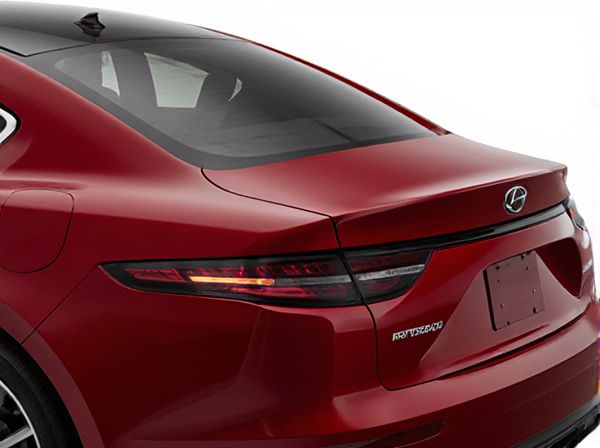
Photo illustration: Notchback vs Liftback
A notchback features a distinct three-box design with a separate trunk, offering clear separation between the cabin and cargo area. Liftbacks combine the sloping rear window and trunk lid into a single, upward-opening hatch, providing easier access and more versatile cargo space. Your choice depends on whether you prioritize traditional styling and trunk security or flexible storage and convenience.
Table of Comparison
| Feature | Notchback | Liftback |
|---|---|---|
| Trunk Design | Separate, fixed trunk lid | Hinged rear window with trunk |
| Trunk Accessibility | Access through a traditional trunk opening | Wider opening, rear seats often fold flat |
| Cargo Space | Limited by fixed trunk size | Flexible, larger volume with folded seats |
| Rear Visibility | Standard rear window view | Often reduced due to angled rear hatch |
| Common Models | Mercedes C-Class, Honda Civic Sedan | Toyota Prius, Volkswagen Scirocco |
Introduction to Notchback and Liftback
Notchback and liftback are distinct car body styles characterized by their rear design and trunk access. Notchback vehicles feature a three-box design with a separate, defined trunk distinct from the passenger compartment, offering traditional aesthetics and practical storage. Liftbacks combine a sloping rear roofline with a large hatch that lifts upwards, blending the style of a coupe with the versatility and cargo space typical of hatchbacks.
Defining Notchback: Key Features
Notchback vehicles feature a distinct three-box design with separate compartments for the engine, passenger, and cargo areas, characterized by a sharply defined rear window and trunk. This design offers enhanced trunk space and a traditional sedan silhouette, favoring aerodynamic efficiency and structural rigidity. Unlike liftbacks, notchbacks maintain a fixed rear window and a conventional trunk lid that opens independently of the rear glass.
What is a Liftback? Essential Characteristics
A liftback is a car body style featuring a rear door that swings upward, combining the practicality of a hatchback with the aerodynamic silhouette of a sedan. Its essential characteristics include a sloping roofline that extends to the rear, providing easy access to the cargo area through a large, vertically hinged rear hatch. This design enhances versatility for loading while maintaining a sportier appearance compared to traditional notchback sedans.
Exterior Design Differences
Notchback vehicles feature a distinct, angular rear with a separate trunk compartment, emphasizing a traditional three-box design that enhances rear visibility and offers a classic silhouette. Liftbacks showcase a more unified rear profile, with a sloping roofline that seamlessly integrates into the rear hatch, providing aerodynamic benefits and easier cargo access. The liftback's continuous slope contrasts with the notchback's defined trunk step, making exterior design the key differentiator between the two body styles.
Interior Space and Practicality
Notchback vehicles typically offer a more defined separation between the cabin and trunk, limiting interior cargo flexibility, while liftbacks feature a rear hatch that opens upwards, providing easier access and greater versatility for loading larger items. Liftbacks often maximize interior space utilization with foldable rear seats and a wider cargo area, enhancing practicality for daily use and travel. The design of liftbacks generally contributes to improved rear headroom and easier ingress, making them preferable for passengers prioritizing spacious interiors and adaptable storage solutions.
Performance and Aerodynamics
Notchback designs typically offer a more rigid structure that can enhance handling performance but may create increased aerodynamic drag compared to liftbacks. Liftback models feature a sloping rear hatch that improves airflow and reduces drag coefficient, resulting in better fuel efficiency and higher top speed potential. The aerodynamic advantage of liftbacks also contributes to improved stability at high speeds, making them preferable for performance-oriented vehicles.
Cargo Capacity Comparison
Notchback vehicles typically offer a traditional trunk design that limits cargo capacity due to restricted access and smaller opening size, whereas liftbacks feature a rear hatch that opens upwards, providing a larger and more versatile cargo area. Liftbacks allow for easier loading of bulky items and often have foldable rear seats to expand cargo volume significantly beyond that of a notchback. When comparing cargo capacity, liftbacks generally outperform notchbacks with cubic footage ranging from 20 to 35 cubic feet, depending on the model, compared to notchbacks which usually provide less than 15 cubic feet in their trunk space.
Cost and Maintenance Considerations
Notchback models typically have lower manufacturing and repair costs due to simpler rear-end designs, resulting in more affordable maintenance expenses over time. Liftbacks often carry higher initial prices and maintenance costs because of their complex tailgate mechanisms and larger rear windows that may require specialized parts. Choosing a notchback can lead to reduced long-term ownership expenses compared to a liftback, especially in regions with limited access to specialized service centers.
Popular Models: Notchback vs Liftback
Popular notchback models include the BMW 3 Series and Audi A4, known for their distinctive three-box design and separate trunk space. In contrast, popular liftback models like the Toyota Prius and Hyundai i30 offer a sloping rear hatch that integrates the cargo area with the passenger cabin, enhancing versatility. The choice between notchback and liftback often depends on preferences for trunk accessibility and cargo space flexibility.
Choosing the Right Body Style for Your Needs
Notchback vehicles feature a distinct three-box design with a separate trunk, offering enhanced cargo security and a traditional sedan aesthetic, making them ideal for buyers prioritizing trunk space and classic styling. Liftback models integrate the rear window and trunk lid into a single, upward-opening hatch, providing easier access to the cargo area and greater versatility for loading larger items, which suits active lifestyles and urban driving. Evaluating your daily transportation needs, cargo habits, and design preferences will guide you in selecting the most practical and visually appealing body style between notchback and liftback options.
 caratoz.com
caratoz.com